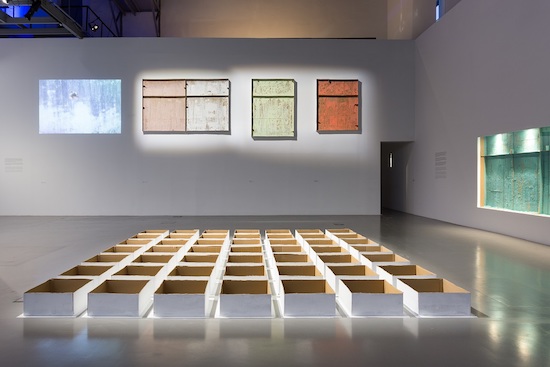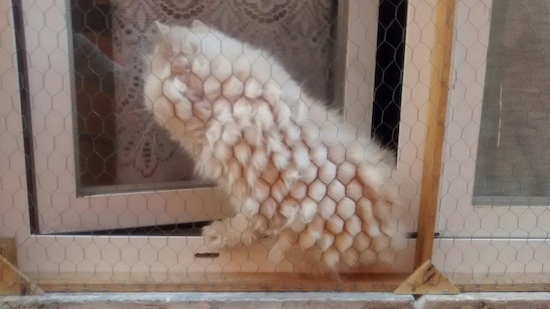Ana Santos does not strictly define her work as sculpture. She sees it more as a process of object creation. Her practice is based on the corporeality and juxtaposition of materials. She opposes metals and fabrics, rigid yet malleable, polished and textured. The spacious room where most of the sculptures hang has fragments of light reflected on the walls, coming from the gleaming metals which Santos chose. These contrast to the different colour and textured fabrics she uses. Curiously, all the works in the exhibition are untitled, which makes it difficult to discuss her pieces. If this move is deliberate (one would hope it is), it is an intelligent move. It fuses her works together, tying discussions surrounding her pieces, and it forces viewers to seek meaning in the sculptures themselves and not their titles.
In Untitled (2018), a dark blue textured fabric is stretched into a rectangular shape and appears contrasted to the ripples of a smooth-edged metal that create the shape of a letter ‘B’. The experience of walking around this work is striking, as the sculpture changes from angle to angle. The profile of the sculpture is prominent, like a wave rising from the gallery wall. Yet as one comes to face it, the work begins to disappear into a thin, polished metallic line. The duality of this piece reflects the interest Santos has on materiality, but also seems to suggest the possibility of being two things at once. Further, as the work ‘melts’ into a single line, there is a sense of utter dissipation, leaving the work with a charged sense of nothingness, of not being.
Another eye-catching piece was Untitled (2018), a work that looks like a broken piping structure in silvery metal, that instead of water, pours out glistening green fabric strings. At the bottom of the structure there are what appear to be scales ‘measuring’ the weight of this material. Piping is a recurring feature in Santos’s work, since its ‘function’ is creating networks, and it is often depicted in her work ruptured. There is a sense lost connections, and a feeling of relations coming apart. Something which the title of the exhibition also seems to suggest.
Santos’s work thrives in being non-figurative and ambiguous, so it is unsurprising that the weakest work in the room had an easily recognisable element – a jacket. Untitled (2018) uses the same technique of contrast between metal structures and fabric. However, unlike her other pieces, this work appears more compact, like compressed metal, lacking the elegance and dynamic lines of the other works in the room. Visually its dark tones were distracting and incongruous, the piece was overbearing in the context of the room, and its inclusion seemed needless.
Apart from the two works I highlighted, the exhibition felt somewhat flat. However, there was a constant attempt to explore the anathema of society, of the contemporary issue of being permanently excluded and detached from reality. In all, Santos’s work can come across as cold and spiritless, but it does attempt to express a need for communication, and it confronts the duality of materiality and existence.

Carlos Bunga – The Architecture of Life: Environments, Paintings and Films, just a single flight of stairs above, is an ambitious retrospective of the artist’s work. It is hard to classify Bunga’s practice. It lies between the boundaries of different media and disciplines. It is a mix of installation, sculpture, architecture, performance, and video art. Bunga has exhibited in the US, Spain, South America, and in other locations. His name is recognised internationally.
The first, most-striking aspect of the exhibition was the sophisticated drawings which seemed taken from an architect’s sketchbook. The lines, the overlapping translucent papers with studies for colour and ergonomics, reminded me of looking at building plans. These drawings, along with videos, document the temporary structures Bunga creates and destroys. His material of choice is cardboard which he colourfully paints. Three televisions, perched in the corner of a room, like security cameras show footage taken from the moment Bunga destroyed his own construction, Kursaal Project, at Manifesta 5 in Donostia–San Sebastián. This relationship between building and destroying can be traced to an event in Bunga’s life. He has pointed to the moment he saw the house he grew up in being demolished as the beginning of this process.
Reflejo (2015-2019), a series of cardboard cubes on the floor, looks like so many open boxes, or an apartment block lying face up with its verandas poking out, creating obstacles and small spaces. There is a sense of wanting to leap between the ‘containers’, like a game, to test the limits of space and its divisions. The excessive organisation and limitations seem to be a challenge to the viewer, who needs to deconstruct boundaries and inhabit space. Only children seemed to live out what was felt around the room, as they jumped about through the installation ignoring the stares of gallery assistants.
The culmination of the exhibition is one of Bunga’s new installations Light Inside (2019), a structure which seems like a pagan chapel, with cardboard vaults bearing openings to let the light in. It was a closed-off, intimate space, where one is at ease, like a small cabin or a hut. In a way, it reminded me of what Gaston Bachelard describes in Poetics of Space, in that, it is a space reminiscent of a first home, it brings a sense of womb-like security. Constructing these structures acts as attempts to recapture a sense of safety, and in destroying it, he lives out his reality, and the trauma of that loss. Inside the installation, an ominous clock ticks as one envisions Bunga destroying the structure.
Although the exhibition was exciting, I had a fleeting sense of visual repetitiveness. However, Bunga’s concept remains relevant – especially, as one considers the precariousness of living spaces and the constant contemporary need for renewal, and therefore destruction.
Both exhibitions were refined, meticulous, creative and highly individual. The artists have solid foundational concepts and create pieces that reflect them – even if, at times, it left feeling like something was missing.
Carlos Bunga, The Architecture Of Life: Environments, Sculptures, Paintings and Films, and Ana Santos, Anátema, are both at MAAT, Lisbon, until 20 May


